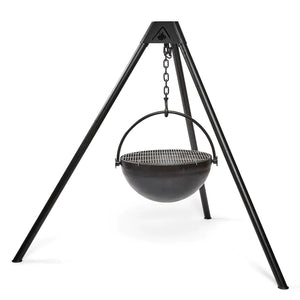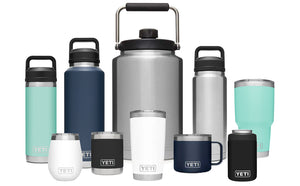The very first Cauldron that was ever made for someone else was made for my good friend Curt. In fact, he’s probably the reason that you can buy one today. I was still a lawyer at the time, and not particularly interested in another career path.
But I made a Ranch Boss for him. It cost me a bundle, but he’s been good to me for a long damn time, and I wanted to do something nice him, and for his delightful wife.
Fast-forward about three years. He was taking his family abroad for a week, and I thought his Cauldron was looking a bit shabby. So I went to the hardware store, bought some high-temp paint, went to his house, and painted his Cauldron basin all nice and inky black. Then I waited for the thank-you’s.
They never came.
Turns out that they really loved the way their Cauldron had taken on an aged patina over time, and I’d sent them all the way back to the “start” square on the monopoly board. Without asking.
So a couple of week later, we are burning at my place with Curt and a few of our other buddies. And yes, we had been drinking.
He says to me, “What would the perfect thing to put on a Cauldron be if you didn’t want to paint it?” And I, in my drunken, western way, replied, “A nice, thick coating of bear fat.”
Everyone laughed, and I went for a new round of drinks.
But it got me thinking. What did people use to protect metal back in the day? I did a bunch of research and learned that the old-time blacksmiths had solved the problem several hundred years ago. If you think about wrought iron, you automatically think about metal that is black. But when a smith is hammering metal, it isn’t black, it’s grey. You know, metal colored. It only turns black once you put the magic coating on it.
So I started experimenting. I literally made the first few batches stirring ingredients over my Cauldron in an old bean pot. It took awhile, but I finally got it right. I put the first batches in mason jars, and put labels on them from my office printer. They looked pretty crude, but they sold like crazy, and the next thing I knew, I couldn’t keep up. Plus, buying so may mason jars had my neighbors wondering if I was in the moonshine business.
Now we have slick new canisters and labels that look like grownups are in charge, which makes me feel pretty good about things.
I’m not going to give the recipe for Bear Fat, but suffice it to say that it’s as close as you can come today to what a blacksmith would have used way back in the day. I’m talking from say the 1200’s to the early 1900’s when modern paints came on the scene. It’s 100% natural, smells great, and has lots of applications. You can put it on leather, on canvas, on wooden tool handles, or damn near anything else that needs protection from the elements, especially water. But it really shines as a metal protectant.
Gatherings of The Cauldron Society have produced lots of wonderful stuff over the years. Laughter, friendship, trust, deep thoughts, shallow thoughts, full bellies, and more than a few hangovers.
And also Bear Fat.





















